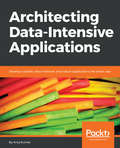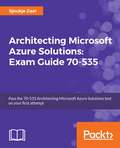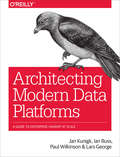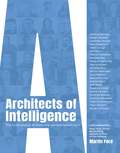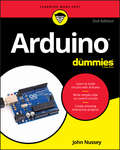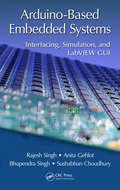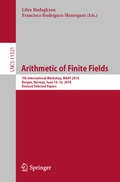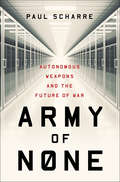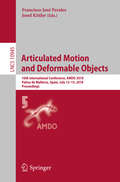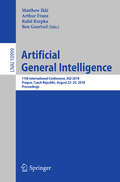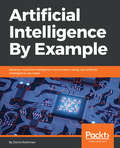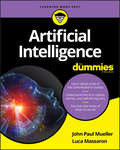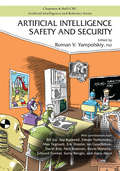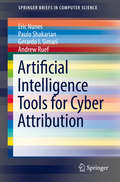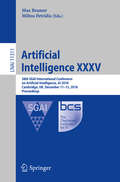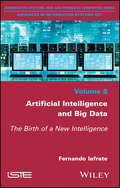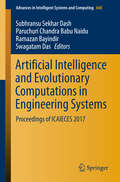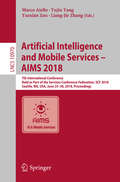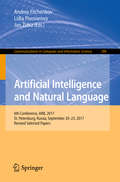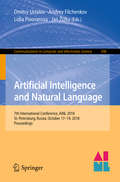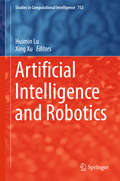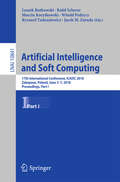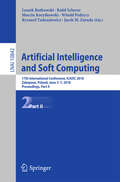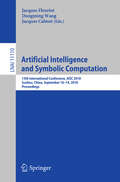- Table View
- List View
Architecting Data-Intensive Applications: Develop scalable, data-intensive, and robust applications the smart way
by Anuj KumarArchitect and design data-intensive applications and, in the process, learn how to collect, process, store, govern, and expose data for a variety of use casesKey FeaturesIntegrate the data-intensive approach into your application architectureCreate a robust application layout with effective messaging and data querying architectureEnable smooth data flow and make the data of your application intensive and fastBook DescriptionAre you an architect or a developer who looks at your own applications gingerly while browsing through Facebook and applauding it silently for its data-intensive, yet fluent and efficient, behaviour? This book is your gateway to build smart data-intensive systems by incorporating the core data-intensive architectural principles, patterns, and techniques directly into your application architecture.This book starts by taking you through the primary design challenges involved with architecting data-intensive applications. You will learn how to implement data curation and data dissemination, depending on the volume of your data. You will then implement your application architecture one step at a time. You will get to grips with implementing the correct message delivery protocols and creating a data layer that doesn’t fail when running high traffic. This book will show you how you can divide your application into layers, each of which adheres to the single responsibility principle. By the end of this book, you will learn to streamline your thoughts and make the right choice in terms of technologies and architectural principles based on the problem at hand.What you will learnUnderstand how to envision a data-intensive systemIdentify and compare the non-functional requirements of a data collection componentUnderstand patterns involving data processing, as well as technologies that help to speed up the development of data processing systemsUnderstand how to implement Data Governance policies at design time using various Open Source ToolsRecognize the anti-patterns to avoid while designing a data store for applicationsUnderstand the different data dissemination technologies available to query the data in an efficient mannerImplement a simple data governance policy that can be extended using Apache FalconWho this book is forThis book is for developers and data architects who have to code, test, deploy, and/or maintain large-scale, high data volume applications. It is also useful for system architects who need to understand various non-functional aspects revolving around Data Intensive Systems.
Architecting Microsoft Azure Solutions – Exam Guide 70-535: A complete guide to passing the 70-535 Architecting Microsoft Azure Solutions exam
by Sjoukje ZaalGet certified as an Azure architect by acing the 70-535 Architecting Microsoft Solutions (70-535) exam using this comprehensive guide with full coverage of the exam objectivesKey FeaturesLearn to successfully design and architect powerful solutions on the Azure Cloud platformEnhance your skills with mock tests and practice questionsA detailed certification guide that will help you ace the 70-535 exam with confidenceBook DescriptionArchitecting Microsoft Azure Solutions: Exam Guide 70-535 will get Azure architects and developers up-to-date with the latest updates on Azure from an architecture and design perspective. The book includes all the topics that are still relevant from the previous 70-534 exam, and is updated with latest topics covered, including Artificial Intelligence, IoT, and architecture styles.This exam guide is divided into six parts, where the first part will give you a good understanding of how to design a compute infrastructure. It also dives into designing networking and data implementations. You will learn about designing solutions for Platform Service and operations. Next, you will be able to secure your resources and data, as well as design a mechanism for governance and policies. You will also understand the objective of designing solutions for Platform Services, by covering Artificial Intelligence, IoT, media services, and messaging solution concepts. Finally, you will cover the designing for operations objective. This objective covers application and platform monitoring, as well as designing alerting strategies and operations automation strategies. By the end of the book, you’ll have met all of the exam objectives, and will have all the information you need to ace the 70-535 exam. You will also have become an expert in designing solutions on Microsoft Azure.What you will learnUse Azure Virtual Machines to design effective VM deploymentsImplement architecture styles, like serverless computing and microservicesSecure your data using different security features and design effective security strategiesDesign Azure storage solutions using various storage featuresCreate identity management solutions for your applications and resourcesArchitect state-of-the-art solutions using Artificial Intelligence, IoT, and Azure Media ServicesUse different automation solutions that are incorporated in the Azure platformWho this book is forThis book is for architects and experienced developers, who are gearing up for the 70-535 exam. Technical architects interested in learning more about designing Cloud solutions will also find this book useful.
Architecting Modern Data Platforms: A Guide to Enterprise Hadoop at Scale
by Paul Wilkinson Lars George Jan Kunigk Ian BussThere’s a lot of information about big data technologies, but splicing these technologies into an end-to-end enterprise data platform is a daunting task not widely covered. With this practical book, you’ll learn how to build big data infrastructure both on-premises and in the cloud and successfully architect a modern data platform.Ideal for enterprise architects, IT managers, application architects, and data engineers, this book shows you how to overcome the many challenges that emerge during Hadoop projects. You’ll explore the vast landscape of tools available in the Hadoop and big data realm in a thorough technical primer before diving into:Infrastructure: Look at all component layers in a modern data platform, from the server to the data center, to establish a solid foundation for data in your enterprisePlatform: Understand aspects of deployment, operation, security, high availability, and disaster recovery, along with everything you need to know to integrate your platform with the rest of your enterprise ITTaking Hadoop to the cloud: Learn the important architectural aspects of running a big data platform in the cloud while maintaining enterprise security and high availability
Architects of Intelligence: The truth about AI from the people building it
by Martin FordFinancial Times Best Books of the Year 2018 TechRepublic Top Books Every Techie Should Read Book Description How will AI evolve and what major innovations are on the horizon? What will its impact be on the job market, economy, and society? What is the path toward human-level machine intelligence? What should we be concerned about as artificial intelligence advances? Architects of Intelligence contains a series of in-depth, one-to-one interviews where New York Times bestselling author, Martin Ford, uncovers the truth behind these questions from some of the brightest minds in the Artificial Intelligence community. Martin has wide-ranging conversations with twenty-three of the world's foremost researchers and entrepreneurs working in AI and robotics: Demis Hassabis (DeepMind), Ray Kurzweil (Google), Geoffrey Hinton (Univ. of Toronto and Google), Rodney Brooks (Rethink Robotics), Yann LeCun (Facebook) , Fei-Fei Li (Stanford and Google), Yoshua Bengio (Univ. of Montreal), Andrew Ng (AI Fund), Daphne Koller (Stanford), Stuart Russell (UC Berkeley), Nick Bostrom (Univ. of Oxford), Barbara Grosz (Harvard), David Ferrucci (Elemental Cognition), James Manyika (McKinsey), Judea Pearl (UCLA), Josh Tenenbaum (MIT), Rana el Kaliouby (Affectiva), Daniela Rus (MIT), Jeff Dean (Google), Cynthia Breazeal (MIT), Oren Etzioni (Allen Institute for AI), Gary Marcus (NYU), and Bryan Johnson (Kernel). Martin Ford is a prominent futurist, and author of Financial Times Business Book of the Year, Rise of the Robots. He speaks at conferences and companies around the world on what AI and automation might mean for the future. Meet the minds behind the AI superpowers as they discuss the science, business and ethics of modern artificial intelligence. Read James Manyika's thoughts on AI analytics, Geoffrey Hinton's breakthroughs in AI programming and development, and Rana el Kaliouby's insights into AI marketing. This AI book collects the opinions of the luminaries of the AI business, such as Stuart Russell (coauthor of the leading AI textbook), Rodney Brooks (a leader in AI robotics), Demis Hassabis (chess prodigy and mind behind AlphaGo), and Yoshua Bengio (leader in deep learning) to complete your AI education and give you an AI advantage in 2019 and the future.
Arduino For Dummies
by John NusseyBring your ideas to life with the latest Arduino hardware and software Arduino is an affordable and readily available hardware development platform based around an open source, programmable circuit board. You can combine this programmable chip with a variety of sensors and actuators to sense your environment around you and control lights, motors, and sound. This flexible and easy-to-use combination of hardware and software can be used to create interactive robots, product prototypes and electronic artwork, whether you’re an artist, designer or tinkerer. Arduino For Dummies is a great place to start if you want to find out about Arduino and make the most of its incredible capabilities. It helps you become familiar with Arduino and what it involves, and offers inspiration for completing new and exciting projects. • Covers the latest software and hardware currently on the market • Includes updated examples and circuit board diagrams in addition to new resource chapters • Offers simple examples to teach fundamentals needed to move onto more advanced topics • Helps you grasp what’s possible with this fantastic little board Whether you’re a teacher, student, programmer, hobbyist, hacker, engineer, designer, or scientist, get ready to learn the latest this new technology has to offer!
Arduino-Based Embedded Systems: Interfacing, Simulation, and LabVIEW GUI
by Rajesh Singh Sushabhan Choudhury Anita Gehlot Bhupendra SinghArduino is an open-source electronics platform based on easy-to-use hardware and software while LabVIEW is a graphical programming telling how to connect functions and work with a variety of datatypes when constructing applications.This book will help beginners to get started with Arduino-based embedded systems including essential know-how of the programming and interfacing of the devices. Book includes programming and simulation of Arduino-based projects and interfacing with LabVIEW, based on practical case studies. The book comprises of total twenty five chapters with description, working model of LabVIEW and programming with Arduino IDE.
Arithmetic of Finite Fields: 7th International Workshop, WAIFI 2018, Bergen, Norway, June 14-16, 2018, Revised Selected Papers (Lecture Notes in Computer Science #11321)
by Lilya Budaghyan Francisco Rodríguez-HenríquezThis book constitutes the thoroughly refereed post-workshop proceedings of the 7th International Workshop on the Arithmetic of Finite Field, WAIFI 2018, held in Bergen, Norway, in June 2018. The 14 revised full papers and six invited talks presented were carefully reviewed and selected from 26 submissions. The papers are organized in topical sections on invited talks; elliptic curves; hardware implementations; arithmetic and applications of finite fields and cryptography.
Army of None: Autonomous Weapons And The Future Of War
by Paul ScharreA Pentagon defense expert and former U.S. Army Ranger explores what it would mean to give machines authority over the ultimate decision of life or death. <P><P> What happens when a Predator drone has as much autonomy as a Google car? Or when a weapon that can hunt its own targets is hacked? Although it sounds like science fiction, the technology already exists to create weapons that can attack targets without human input. Paul Scharre, a leading expert in emerging weapons technologies, draws on deep research and firsthand experience to explore how these next-generation weapons are changing warfare. <P><P> Scharre’s far-ranging investigation examines the emergence of autonomous weapons, the movement to ban them, and the legal and ethical issues surrounding their use. He spotlights artificial intelligence in military technology, spanning decades of innovation from German noise-seeking Wren torpedoes in World War II—antecedents of today’s homing missiles—to autonomous cyber weapons, submarine-hunting robot ships, and robot tank armies. Through interviews with defense experts, ethicists, psychologists, and activists, Scharre surveys what challenges might face "centaur warfighters" on future battlefields, which will combine human and machine cognition. We’ve made tremendous technological progress in the past few decades, but we have also glimpsed the terrifying mishaps that can result from complex automated systems—such as when advanced F-22 fighter jets experienced a computer meltdown the first time they flew over the International Date Line. <P><P>At least thirty countries already have defensive autonomous weapons that operate under human supervision. Around the globe, militaries are racing to build robotic weapons with increasing autonomy. The ethical questions within this book grow more pressing each day. To what extent should such technologies be advanced? And if responsible democracies ban them, would that stop rogue regimes from taking advantage? At the forefront of a game-changing debate, Army of None engages military history, global policy, and cutting-edge science to argue that we must embrace technology where it can make war more precise and humane, but without surrendering human judgment. When the choice is life or death, there is no replacement for the human heart.
Articulated Motion and Deformable Objects: 10th International Conference, AMDO 2018, Palma de Mallorca, Spain, July 12-13, 2018, Proceedings (Lecture Notes in Computer Science #10945)
by Josef Kittler Francisco José PeralesThis book constitutes the refereed proceedings of the 10th International Conference on Articulated Motion and Deformable Objects, AMDO 2018, held in Palma de Mallorca, Spain, in July 2018.The 12 papers presented were carefully reviewed and selected from 26 submissions. The papers address the following topics: advanced computer graphics and immersive videogames; human modeling and animation; human motion analysis and tracking; 3D human reconstruction and recognition; multimodal user interaction and applications; ubiquitous and social computing; design tools; input technology; programming user interfaces; 3D medical deformable models and visualization; deep learning methods for computer vision and graphics; and multibiometric.
Artificial General Intelligence: 11th International Conference, AGI 2018, Prague, Czech Republic, August 22-25, 2018, Proceedings (Lecture Notes in Computer Science #10999)
by Ben Goertzel Matthew Iklé Arthur Franz Rafal RzepkaThis book constitutes the proceedings of the 11th International Conference on Artificial General Intelligence, AGI 2018, held in Prague, Czech Republic, in August 2018. The 19 regular papers and 10 poster papers presented in this book were carefully reviewed and selected from 52 submissions. The conference encourage interdisciplinary research based on different understandings of intelligence, and exploring different approaches. As the AI field becomes increasingly commercialized and well accepted, maintaining and emphasizing a coherent focus on the AGI goals at the heart of the field remains more critical than ever.
Artificial Intelligence By Example: Develop machine intelligence from scratch using real artificial intelligence use cases
by Denis RothmanBe an adaptive thinker that leads the way to Artificial IntelligenceKey FeaturesAI-based examples to guide you in designing and implementing machine intelligenceDevelop your own method for future AI solutionsAcquire advanced AI, machine learning, and deep learning design skillsBook DescriptionArtificial Intelligence has the potential to replicate humans in every field. This book serves as a starting point for you to understand how AI is built, with the help of intriguing examples and case studies.Artificial Intelligence By Example will make you an adaptive thinker and help you apply concepts to real-life scenarios. Using some of the most interesting AI examples, right from a simple chess engine to a cognitive chatbot, you will learn how to tackle the machine you are competing with. You will study some of the most advanced machine learning models, understand how to apply AI to blockchain and IoT, and develop emotional quotient in chatbots using neural networks.You will move on to designing AI solutions in a simple manner rather than get confused by complex architectures and techniques. This comprehensive guide will be a starter kit for you to develop AI applications on your own.By the end of this book, will have understood the fundamentals of AI and worked through a number of case studies that will help you develop business vision.What you will learnUse adaptive thinking to solve real-life AI case studiesRise beyond being a modern-day factory code workerAcquire advanced AI, machine learning, and deep learning designing skillsLearn about cognitive NLP chatbots, quantum computing, and IoT and blockchain technologyUnderstand future AI solutions and adapt quickly to themDevelop out-of-the-box thinking to face any challenge the market presentsWho this book is forArtificial Intelligence by Example is a simple, explanatory, and descriptive guide for junior developers, experienced developers, technology consultants, and those interested in AI who want to understand the fundamentals of Artificial Intelligence and implement it practically by devising smart solutions. Prior experience with Python and statistical knowledge is essential to make the most out of this book.
Artificial Intelligence For Dummies
by John Paul Mueller Luca MassaronStep into the future with AI The term "Artificial Intelligence" has been around since the 1950s, but a lot has changed since then. Today, AI is referenced in the news, books, movies, and TV shows, and the exact definition is often misinterpreted. Artificial Intelligence For Dummies provides a clear introduction to AI and how it’s being used today. Inside, you’ll get a clear overview of the technology, the common misconceptions surrounding it, and a fascinating look at its applications in everything from self-driving cars and drones to its contributions in the medical field. Learn about what AI has contributed to society Explore uses for AI in computer applications Discover the limits of what AI can do Find out about the history of AI The world of AI is fascinating—and this hands-on guide makes it more accessible than ever!
Artificial Intelligence Safety and Security (Chapman & Hall/CRC Artificial Intelligence and Robotics Series)
by Roman V. YampolskiyThe history of robotics and artificial intelligence in many ways is also the history of humanity’s attempts to control such technologies. From the Golem of Prague to the military robots of modernity, the debate continues as to what degree of independence such entities should have and how to make sure that they do not turn on us, its inventors. Numerous recent advancements in all aspects of research, development and deployment of intelligent systems are well publicized but safety and security issues related to AI are rarely addressed. This book is proposed to mitigate this fundamental problem. It is comprised of chapters from leading AI Safety researchers addressing different aspects of the AI control problem as it relates to the development of safe and secure artificial intelligence. The book is the first edited volume dedicated to addressing challenges of constructing safe and secure advanced machine intelligence. The chapters vary in length and technical content from broad interest opinion essays to highly formalized algorithmic approaches to specific problems. All chapters are self-contained and could be read in any order or skipped without a loss of comprehension.
Artificial Intelligence Tools for Cyber Attribution ( SpringerBriefs in Computer Science)
by Gerardo I. Simari Paulo Shakarian Eric Nunes Andrew RuefThis SpringerBrief discusses how to develop intelligent systems for cyber attribution regarding cyber-attacks. Specifically, the authors review the multiple facets of the cyber attribution problem that make it difficult for “out-of-the-box” artificial intelligence and machine learning techniques to handle. <P><P> Attributing a cyber-operation through the use of multiple pieces of technical evidence (i.e., malware reverse-engineering and source tracking) and conventional intelligence sources (i.e., human or signals intelligence) is a difficult problem not only due to the effort required to obtain evidence, but the ease with which an adversary can plant false evidence.<P> This SpringerBrief not only lays out the theoretical foundations for how to handle the unique aspects of cyber attribution – and how to update models used for this purpose – but it also describes a series of empirical results, as well as compares results of specially-designed frameworks for cyber attribution to standard machine learning approaches.<P> Cyber attribution is not only a challenging problem, but there are also problems in performing such research, particularly in obtaining relevant data. This SpringerBrief describes how to use capture-the-flag for such research, and describes issues from organizing such data to running your own capture-the-flag specifically designed for cyber attribution. Datasets and software are also available on the companion website.
Artificial Intelligence XXXV: 38th SGAI International Conference on Artificial Intelligence, AI 2018, Cambridge, UK, December 11–13, 2018, Proceedings (Lecture Notes in Computer Science #11311)
by Max Bramer Miltos PetridisThis book constitutes the proceedings of the 38th SGAI International Conference on Innovative Techniques and Applications of Artificial Intelligence, AI 2018, held in Cambridge, UK, in December 2018. The 25 full papers and 12 short papers presented in this volume were carefully reviewed and selected from 46 submissions. There are technical and application papers which were organized in topical sections named: Neural Networks; Planning and Scheduling; Machine Learning; Industrial Applications of Artificial Intelligence; Planning and Scheduling in Action; Machine Learning in Action; Applications of Machine Learning; and Applications of Agent Systems and Genetic Algorithms.
Artificial Intelligence and Big Data: The Birth of a New Intelligence
by Fernando IafrateWith the idea of “deep learning” having now become the key to this new generation of solutions, major technological players in the business intelligence sector have taken an interest in the application of Big Data. In this book, the author explores the recent technological advances associated with digitized data flows, which have recently opened up new horizons for AI. The reader will gain insight into some of the areas of application of Big Data in AI, including robotics, home automation, health, security, image recognition and natural language processing.
Artificial Intelligence and Evolutionary Computations in Engineering Systems: Proceedings Of ICAIECES 2017 (Advances In Intelligent Systems And Computing #668)
by Swagatam Das Subhransu Sekhar Dash Paruchuri Chandra Babu Naidu Ramazan BayindirComprises contributions by the research scholars and academicians across the globe.<p><p> The book is a collection of high-quality peer-reviewed research papers presented in the International Conference on Artificial Intelligence and Evolutionary Computations in Engineering Systems (ICAIECES 2017). The book discusses wide variety of industrial, engineering and scientific applications of the emerging techniques. Researchers from academia and industry have presented their original work and ideas, information, techniques and applications in the field of communication, computing and power technologies.
Artificial Intelligence and Mobile Services – AIMS 2018: 7th International Conference, Held as Part of the Services Conference Federation, SCF 2018, Seattle, WA, USA, June 25-30, 2018, Proceedings (Lecture Notes in Computer Science #10970)
by Marco Aiello Liang-Jie Zhang Yujiu Yang Yuexian ZouThis book constitutes the proceedings of the International Conference on Artificial Intelligence and Mobile Services, AIMS 2018, held as part of SCF 2018, in Seattle, WA, USA, in June 2018. The 20 papers presented in this volume were carefully reviewed and selected from numerous submissions. The papers cover different aspects of mobile services from business management to computing systems, algorithms and applications. They promote technological technological innovations in research and development of mobile services, including, but not limited to, wireless and sensor networks, mobile and wearable computing, mobile enterprise and eCommerce, ubiquitous collaborative and social services, machine-to-machine and Internet-of-things, clouds, cyber-physical integration, and big data analytics for mobility-enabled services
Artificial Intelligence and Natural Language: 6th Conference, Ainl 2017, St. Petersburg, Russia, September 20-23, 2017, Revised Selected Papers (Communications In Computer And Information Science #789)
by Jan Žižka Andrey Filchenkov Lidia PivovarovaThis book constitutes the refereed proceedings of the 6th Conference on Artificial Intelligence and Natural Language, AINL 2017, held in St. Petersburg, Russia, in September 2017. The 13 revised full papers, 4 revised short papers papers were carefully reviewed and selected from 35 submissions. The papers are organized in topical sections on social interaction analysis, speech processing, information extraction, Web-scale data processing, computation morphology and word embedding, machine learning. The volume also contains 6 papers participating in the Russian paraphrase detection shared task.
Artificial Intelligence and Natural Language: 7th International Conference, AINL 2018, St. Petersburg, Russia, October 17–19, 2018, Proceedings (Communications in Computer and Information Science #930)
by Jan Žižka Andrey Filchenkov Lidia Pivovarova Dmitry UstalovThis book constitutes the refereed proceedings of the 7th Conference on Artificial Intelligence and Natural Language, AINL 2018, held in St. Petersburg, Russia, in October 2018. The 19 revised full papers were carefully reviewed and selected from 56 submissions and cover a wide range of topics, including morphology and word-level semantics, sentence and discourse representations, corpus linguistics, language resources, and social interaction analysis.
Artificial Intelligence and Robotics (Studies in Computational Intelligence #752)
by Huimin Lu Xing XuThis book highlights selected papers presented at the 2nd International Symposium on Artificial Intelligence and Robotics 2017 (ISAIR2017), held in Nakamura Centenary Memorial Hall, Kitakyushu, Japan on November 25-26, 2017. Today, the integration of artificial intelligence and robotic technologies has become a topic of growing interest for both researchers and developers from academic fields and industries worldwide, and artificial intelligence is poised to become the main approach pursued in next-generation robotics research. The rapidly growing number of artificial intelligence algorithms and big data solutions has significantly extended the number of potential applications for robotic technologies. However, it also poses new challenges for the artificial intelligence community. The aim of this symposium is to provide a platform for young researchers to share the latest scientific achievements in this field, which are discussed in these proceedings.
Artificial Intelligence and Social Work (Artificial Intelligence for Social Good)
by Eric Rice Milind TambeThis book marries social work and artificial intelligence to provide an introductory guide for using AI for social good. Following an introductory chapter laying out approaches and ethical principles of using AI for social work interventions, the book describes in detail an intervention to increase the spread of HIV information by using algorithms to determine the key individuals in a social network of homeless youth. Other chapters present interdisciplinary collaborations between AI and social work students, including a chatbot for sexual health information and algorithms to determine who is at higher stress among persons with Type 2 Diabetes. For students, academic researchers, industry leaders, and practitioners, these real-life examples from the USC Center for Artificial Intelligence in Society demonstrate how social work and artificial intelligence can be used in tandem for the greater good.
Artificial Intelligence and Soft Computing: 17th International Conference, ICAISC 2018, Zakopane, Poland, June 3-7, 2018, Proceedings, Part I (Lecture Notes in Computer Science #10841)
by Witold Pedrycz Leszek Rutkowski Marcin Korytkowski Rafał Scherer Ryszard Tadeusiewicz Jacek M. ZuradaThe two-volume set LNAI 10841 and LNAI 10842 constitutes the refereed proceedings of the 17th International Conference on Artificial Intelligence and Soft Computing, ICAISC 2018, held in Zakopane, Poland in June 2018. The 140 revised full papers presented were carefully reviewed and selected from 242 submissions. The papers included in the first volume are organized in the following three parts: neural networks and their applications; evolutionary algorithms and their applications; and pattern classification.
Artificial Intelligence and Soft Computing: 17th International Conference, ICAISC 2018, Zakopane, Poland, June 3-7, 2018, Proceedings, Part II (Lecture Notes in Computer Science #10842)
by Witold Pedrycz Leszek Rutkowski Marcin Korytkowski Rafał Scherer Ryszard Tadeusiewicz Jacek M. ZuradaThe two-volume set LNAI 10841 and LNAI 10842 constitutes the refereed proceedings of the 17th International Conference on Artificial Intelligence and Soft Computing, ICAISC 2018, held in Zakopane, Poland in June 2018. The 140 revised full papers presented were carefully reviewed and selected from 242 submissions. The papers included in the second volume are organized in the following five parts: computer vision, image and speech analysis; bioinformatics, biometrics, and medical applications; data mining; artificial intelligence in modeling, simulation and control; and various problems of artificial intelligence.
Artificial Intelligence and Symbolic Computation: 13th International Conference, AISC 2018, Suzhou, China, September 16–19, 2018, Proceedings (Lecture Notes in Computer Science #11110)
by Jacques Fleuriot Dongming Wang Jacques CalmetThis book constitutes the refereed proceedings of the 13th International Conference on Artificial Intelligence and Symbolic Computation, AISC 2018, held in Suzhou, China, in September 2018. The 13 full papers presented together with 5 short and 2 invited papers were carefully reviewed and selected from 31 submissions. The AISC conference is an important forum when it comes to ensuring that ideas, theoretical insights, methods and results from traditional AI can be discussed and showcased, while fostering new links with other areas of AI such as probabilistic reasoning and deep learning.
